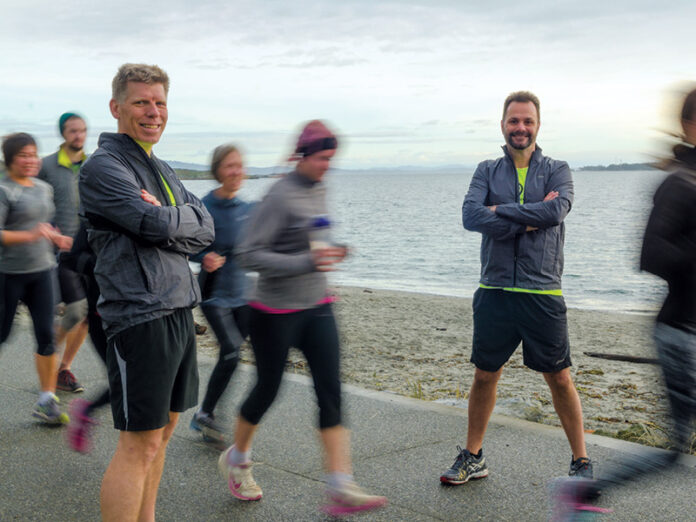
It’s another Saturday in the marathon clinic — except it’s a different location, the distance is longer and has more tempos. There is a buzz in the group, everyone gathers around to hear the instructions from the run leaders — tips on the route, where the tempos are and when to take in your nutrition. And, perhaps more importantly, where everyone is going for coffee afterwards. Then they are off.
Run leaders, for the most part, are volunteers who devote hours of their own time to assist individuals to reach their goals, whether it’s learning to run, running a 10K or half-marathon for the first time, or setting a marathon PB. These unsung heroes may not have any formal coaching or training experience, just the love of running and sharing their passion with others.
Stephen Curran and Jamie Morgan are the run coordinators for the Frontrunners Victoria clinics. Curran, a software engineer, and Morgan, a small business owner, recruit 14 to 16 leaders for their half and marathon clinics. While they have many returning leaders, they also look for new blood.
“We often recruit leaders from within the clinic, but they have to have an aptitude for it and be A-type people,” says Morgan. With 140-plus in the clinics, the pace groups can be large. “Ideally there are two run leaders per pace group, but we may we have to make adjustments depending on the size,” adds Curran.
David Marlor does a lot of research for his routes. A planning director in Victoria, he has been a run leader for the half and marathon clinics for five years. He considers the length of the run and the number of tempos that day.
“I also consider which race the runners are training for. We have to adjust the distance for those running a race earlier or later, so I try to design routes so that those runners can drop out after a certain distance, and others continue,” he says.
Jonathan Foweraker, a first-time clinic leader, who works for the B.C. government, has other criteria: “Ensure the route isn’t too flat. If you train on hills, then you’re prepared to run them in a race. Also make it safe, quiet and rural, if possible, and ensure there are washrooms,” he says.
Juliana Harris, a Master’s student and a clinic leader with Strides Running in Calgary, says a leader is like a tour guide. “We get to plan some great routes and with many of our participants new to the city, we take them to places they haven’t been before.”
Harris had been a Strides run leader for 18 months, putting her personal goals on the back burner. “It makes me feel positive and I enjoy sharing other people’s successes.”
“I enjoy seeing growth in people when they challenge themselves or don’t think they can do a particular run and they do,” says Connie Robertson, an assistant hotel manager by day, and a Frontrunners clinic leader at night. “I like helping my group with consistency and tips to help them achieve their goals. Teach them that it’s fun to be out there supporting each other.”
“I like seeing the progression and improvement in my group, and being able to help, advise and counsel the group during good times and bad,” says Foweraker.
Generally, clinics recruit from their own ranks, so if you want to try your hand at being a run leader, visit your local running store and join a clinic first and get to know the groups and the time commitment.
Curran has some advice: “When we recruit we say: who do we see as good runners and are they able to do the route planning for the Saturday runs? If you want to give back, being a run leader can be a very rewarding experience.”













